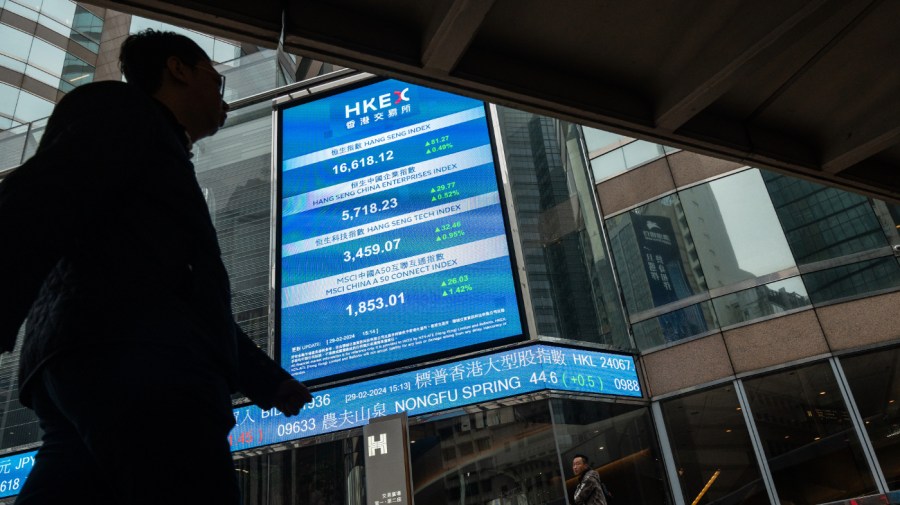
One of the top priorities of China’s policymakers has been to stabilize the country’s equity and property markets. China’s stock market has trailed the S&P 500 index substantially since 2017, and the gap has increased in the past few years as the property bubble burst.
China had the worst return among markets in the MSCI World index last year, and the loss in value of both mainland and Hong Kong-listed stocks from the peak in 2021 now exceeds $6 trillion according to Fortune.
In response, China’s government has adopted a series of measures to bolster the markets and stem foreign capital flight. Yet, domestic investors are also losing confidence in economic policies, as problems in the property sector are spreading, a record number of young people are unemployed and the country is flirting with deflation.
Earlier this month investors were focused on the National People’s Congress in Beijing, where China’s leaders unveiled plans about the country’s medium-term economic objectives. In the keynote speech, Premier Li Qiang reaffirmed the government’s target growth rate of 5 percent but offered no assessment of how it would be achieved. Scott Campbell of Time contends that policymakers appear to have their “head in the sand.”
Some investors were disappointed that the government did not announce plans to increase spending to bolster the economy and property market. However, with China’s overall debt to GDP at a record 288 percent last year, additional debt-financed spending would only exacerbate the problem of economic inefficiency.
Rather, the key issue confronting China is the need to tackle its massive excess savings. To do so, the government should re-embark on economic reforms incentivizing households to increase consumption, which is less than 40 percent of GDP.
This goal has topped the list of the country’s policy priorities since 2007, a year before Western economies were reeling from the 2008 global financial crisis. Subsequently, China’s five-year plan covering 2011-15 called for transitioning the economy from export and investment-led growth to greater reliance on domestic consumption. This goal was reiterated in the latest government plan that covers the period from 2022 to 2035.
Thus far, however, there is little to show for it, and the problem of excess saving is becoming intractable.
Martin Wolf of the Financial Times points out that China generated 28 percent of global savings in 2023 according to the IMF. This tally is only a little less than the 33 percent share of the U.S. and European Union combined.
He points out two important implications. First, if China were an open market economy, its capital markets would be the largest in the world. Second, how these savings are managed would be the most important determinant of global interest rates and the global balance of payments.
If the share of domestic consumption to GDP fails to increase and the budget imbalance is unchanged, the gap between domestic savings and investment would be channeled either as increased capital flight from China or increased exports from China to the rest of the world. With China’s government aiming to expand production of electronic vehicles, the risk of a renewed trade conflict between China and the U.S. and EU is likely to increase in the next year or two, as I have warned previously.
Another risk is that troubles in the property sector will continue to weigh on consumer confidence.
A New York Federal Reserve report points to a recent survey conducted by the People’s Bank of China that documents growing concerns among property owners in the country. The survey shows that 15 percent of households have suffered declines in income since the pandemic struck, and some 43 percent of respondents were insecure about their jobs. Accordingly, 60 percent of households surveyed told the People’s Bank of China they must prioritize saving over consumption.
During the 10 years before COVID, household borrowing averaged over 25 percent annually to finance real estate purchases according to the New York Federal Reserve. Property was the most important store of value for households, accounting for roughly two-thirds of household assets, while over 80 percent owned residences.
Subsequently, as their balance sheets suffered amid the collapse of economic activity that ensued, households responded by paying down mortgage debt and increasing long-term bank deposits to earn interest income. Yet, as the Bank of China eases monetary policy to combat the risk of deflation, their incentives to continue doing so may lessen over time.
So, what can the Chinese government do to rebuild consumer confidence?
My assessment is it will not be easy for two reasons. First, whenever confidence is shattered it inevitably takes considerable time to rebuild public trust. Second, the government has repeatedly failed to adopt policies to transform China’s development model away from export and investment-led growth to rely more on domestic consumption. Moreover, it shows no inclination to do so now, as it has placed political priorities ahead of economic goals.
Finally, I do not foresee China’s property bubble playing out as it did in Japan in the 1990s or the U.S. 15 years ago, because China’s government controls the banking system. Rather, it will likely be a slow, steady grind that will weigh on the country’s growth prospects for years to come.
In these circumstances, the government’s attempts to bolster China’s stock and property market face a steep uphill battle.
Nicholas Sargen, Ph.D., is an economic consultant for Fort Washington Investment Advisors and is affiliated with the University of Virginia’s Darden School of Business. He has authored three books including “Global Shocks: An Investment Guide for Turbulent Markets.”
Copyright 2024 Nexstar Media Inc. All rights reserved. This material may not be published, broadcast, rewritten, or redistributed.














